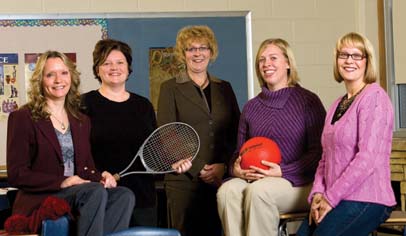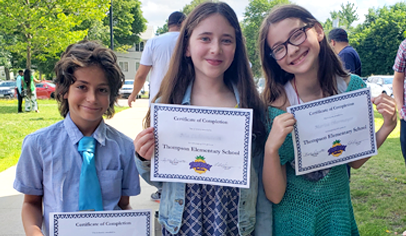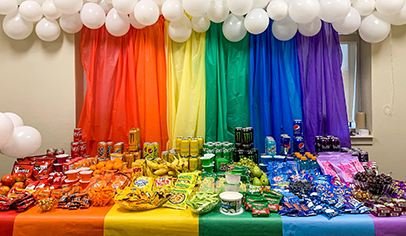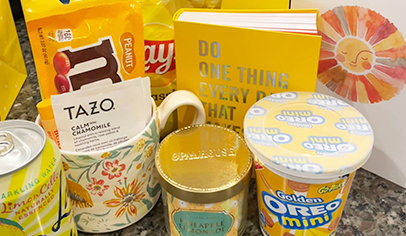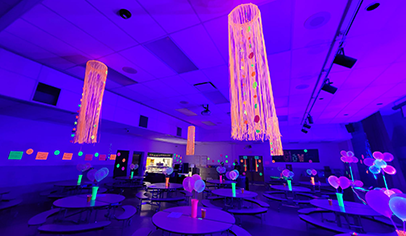It’s 3:30 p.m. on a Tuesday, and dozens of students at Badger Middle School in West Bend, Wis., are still hanging around campus—with good reason. Their principal, Art Bergman, and the school parent group have created a summer-camp-like atmosphere there ever since they launched an exciting lineup of after-school activities under their “cocurriculars” program. Only there’s no hefty camper’s fee; all the clubs here are free.
“We as a group felt it was important for kids to be exposed to many different programs,” says Badger Parent Group president Jackie Mages. “This allows them to find other interests and allows them to view school not just as a place they have to be, but also as a place they want to be.” Each club is teacher-led and runs for about eight weeks on Tuesdays or Thursdays; students can enroll in any or all of three sessions during the year. Enrollment is capped at 25 students per club, and some, such as Ping-Pong, have waiting lists.
Bergman first pitched the idea for cocurriculars to the parent group in fall 2008; Mages and her coleaders unanimously approved the request and allocated a budget of $6,000. “Students who are involved in activities and connected to school tend do better academically and behaviorally in school,” Bergman explains. “This program provides a positive, fun experience which fills an after-school void for many of our students.”
According to Nicole Minor, a Badger teacher and cocurriculars coordinator, the program also helps keep kids safe and occupied during a vulnerable time of day. “Many of the students join the clubs because their parents are not home at night when they get home, they do not have many friends, and this is a way for them to meet people and just to stay active,” she says.
“Active” might be an understatement. Depending on the day, students can take up fishing, tennis, soccer, scrapbooking, or cheerleading, among other things. “For students in Ping-Pong and competitive sports, it is a way to release their energy at the end of the day and have fun with peers in all grade levels,” Minor says. For others, like Mages’ son, Alexander, it’s about creative expression—he and another student participated in a video club and produced a DVD about the school for new parents. Cocurriculars slated for spring 2010 include a debate club and a strategy board games club featuring The Settlers of Catan and Ticket To Ride.
One major way parents support the cocurriculars program is by attending the annual Beach Blast family fun night, which includes a silent auction, raffles, food, and music. Last year’s Beach Blast raised more than $7,000; the proceeds were allocated to pay teachers’ stipends and purchase table tennis sets, video equipment, and other materials.
Annual costs to run the cocurriculars are about $3,500, a small investment considering the wide-reaching effect it has had on Badger’s students as well as the staff. “For teachers running the clubs,” Mages says, “it has been a way to build relationships with students at Badger and get to know them on a whole new level.”
The Group
Badger Middle School Parent Group, West Bend, Wis.
School size: 904 students, grades 6-8
Annual budget: $13,000
Fundraisers: Beach Blast family night, Market Day, concession sales, supermarket/store loyalty cards
Philosophy: To foster positive relationships between the students, teachers, staff, and parents; to be involved even on the smallest of levels will make a difference in a student’s life.
Cocurriculars Program
An array of after-school clubs and activities for students led by teachers and funded by the parent group
It’s all in the details: According to parent group president Jackie Mages, the key to running a great after-school program is to tap a coordinator with good organization and planning skills, preferably a teacher or other staff member who can be on-site. Her advice: “Survey the kids and find out what programs they want, and find staff who will be committed before you advertise the program.”
Mixing it up: The cocurriculars are widely attended because of the number and variety of clubs offered. Students can elect to learn tennis, practice knitting, or go fishing; they can also take up a game of Ping-Pong or the card game Sheepshead. “Our goal is to provide something for everyone,” Mages explains.
Getting the word out: Cocurriculars coordinator Nicole Minor publicizes the clubs through announcements at school, flyers in teacher mailboxes, and notices in the school’s weekly email newsletter. “It usually takes a couple of weeks for the kids to catch wind, even when you provide tons of flyers,” she says. “The teachers at Badger do a wonderful job of promoting them through word of mouth to students and parents.”


